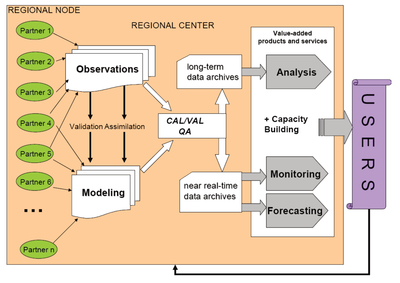WMO Vegetation Fire and Smoke Pollution Warning Advisory and Assessment System (VFSP-WAS)

Introduction
Vegetation fires release large amounts of particulate matter (PM) and toxic gases including carbon monoxide, nitrogen oxides, and non-methane organic compounds into the atmosphere. Studies have demonstrated that smoke PM from vegetation fires is associated with respiratory and cardiovascular effects and that exposure to fire emissions represents the highest risk to vulnerable subsets of the population i.e. people with existing respiratory or cardiovascular illnesses, infants and the elderly.
Recognising the need for international coordination of a diverse community dealing with the societal impacts of fires and smoke pollution, the World Meteorological Organization (WMO) Global Atmosphere Watch (GAW) Programme has taken the lead with international partners to develop and implement the VFSP-WAS. The VFSP-WAS is an international network of research, national operational centres and users organised through regional nodes assisted by regional centres.
For more information, refer to:
Mission
The VFSP-WAS aims to enhance the ability of countries to deliver timely and quality vegetation fire and smoke pollution forecasts, observations, information and knowledge to users through an international partnership of research and operational communities.

Objectives
1. To provide data and information that can be used to capacitate relevant actors regionally, nationally and locally to reach informed decisions as they work to prevent destructive fires.
2. To provide data and information that is relevant and helpful for specific agencies in individual countries that are tasked with dealing with emergencies in the context of public health, fire management and law enforcement.
3. To provide data and information that can be used by the Regional Fire Management Resource Centres in the effort to advise and capacitate relevant actors regionally, nationally and locally to develop fire management policies and implementation strategies and reach informed decisions in fire management.
4. To facilitate the use of fire and smoke prediction at the regional level, to protect health, economic activities and the environment.
5. To facilitate the use of fire and smoke observations by users regionally, nationally and locally.
6. To provide centralised expertise to regional WMO Members, advice and training to support the establishment and improvement of fire and smoke observations and predictions.

Regional Nodes and Centres
At the regional level, VFSP-WAS is organised as a federation of regional partners and realised through regional activity Nodes and Regional Vegetation Fire and Smoke Pollution Warning and Advisory Centres (RVFSP-WAC). The organisation of regional nodes research, development and forecasting activities within each node is defined and led by a VFSP-WAS Regional Steering Group (RSG) and coordinated by the Regional Centre.

First Regional VFSP-WAS R&D Centres:
- SE Asia VFSP-WAS center in Singapore is available here.
- North America VFSP-WAS Center at ECCC is available here
Publications:
- The WMO Vegetation Fire and Smoke Pollution Warning Advisory and Assessment System (VFSP-WAS): Concept, Current Capabilities, Research and Development Challenges and the Way Ahead, DOI: 10.37002/biobrasil.v11i2.1738
- WMO GAW Report No. 235 – Vegetation Fire and Smoke Pollution Warning and Advisory System (VFSP-WAS): Concept Note and Expert Recommendations
- Historic global biomass burning emissions based on merging satellite observations with proxies and fire models (1750–2015). van Marle, M., Kloster, S., Magi, B., Marlon, J., Daniau, A., Field, R., Arneth, A., Forrest, M., Hantson, S., Kehrwald, N., Knorr, W., Lasslop, G., Li, F., Mangeon, S., Yue, C., Kaiser, J., and van der Werf, G. (2017). Geosci. Model Dev., 10:3329–3357.
- Interdisciplinary Research Aspects of Open Biomass Burning and its Impact on the Atmosphere Special Issue (2015) Eds. J.W. Kaiser and M. Keywood. Atmos. Env.. 121: IBBI Special Issue.
- Benedetti A, et al. Status and future of numerical atmospheric aerosol prediction with a focus on data requirements. Atmospheric Chemistry and Physics, 18: 10615–10643, 2018.
Events, conferences, presentations
- GFMC News-International Landscape Fire Meetings 2018-2022, and Archive 1998-2017, Portal webpage is available here.
- Numerical Wildfire 2020, May 11 - 15, 2020 (postponed to 2021), IESC, Cargese, Corsica, France, Event Website is available here.
- Presentations from the WMO VFSP-WAS Session on the WildFires Conference is available here.
- WMO VFSP-WAS Session on the WildFires conference (7th Wildland Fire Conference (IWFC-7), Campo Grande, Mato Grosso do Sul, Brazil, October 28 – November 1, 2019), is available here.
- Technical Report of International organizations (WMO, WHO, PAHO, IBBI, GFMC) on the WildFires Conference: is available here.
- The Session Agenda is available here.
- IBBI Workshop, 10-11 July 2017, Boulder, CO, USA is available here.
IGACnews Workshop Summary, Event Website
Participant List, Agenda
- WMO GAW & IBBI workshop Forecasting Emissions from Vegetation Fires and their Impacts on Human Health and Security in South East Asia, Indonesian Agency for Meteorological, Climatology and Geophysics (BMKG), Jakarta, Indonesia, 29 August – 1 September 2016. First announcement. Second announcement. IGACnews Workshop Summary
Links to web-sites:
- APP SAG web-sites is available here.
- Copernicus CAMS web-sites is available here.
- GAFIS web-sites is available here.
- Global Fire Monitoring Center (GFMC) is available here.
- Global Wildland Fire Network (GWFN) is available here.
- Global Wildfire Information System (GWIS) web-sites of the Group on Earth Observations (GEO) and the Copernicus is available here.
- Interdisciplinary Biomass Burning Initiative (IBBI) web-site is available here.
- SDS-WAS web-site is available here.
- WMO Global Data-Processing and Forecasting System web-sites is available here.
- WWRP S2S Project web-sites is available here.
